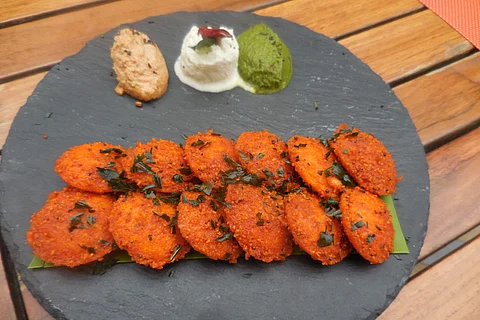

After a pleasant drive on National Highway 209, cruising past the scenic Karnataka countryside, we stopped for breakfast in the nondescript hamlet of Halaguru, 80 km from Bengaluru. We tried the steaming, rustic chiblu idli at Babu Hotel, a smoke-filled, tiny eatery on Malavalli Main Road. What makes it distinctive is that these idlis are made sans idli stands. In the absence of steamers, residents would steam idlis in small baskets, known as ‘chiblus’ in Kannada, made of bamboo and cooked over a wood-stoked fire. It is a small bowl shaped out of woven bamboo that moulds the idli to a perfect circle. We savoured the soft, aromatic chiblu idlis slathered with a huge dollop of homemade butter and served with some palya (fried vegetable dish) and spicy chilli chutney.
The humble idli has gone through several transformations that have resulted in many versions in Karnataka. According to food historian KT Achaya’s book Indian Food: A Historical Companion, the cooks employed by the kings of Hindu-Buddhist kingdoms in Indonesia might have been the brains behind the invention of the idli and the ones responsible for bringing back the recipe. According to Achaya, the first mention of idli was seen in a 10th century Kannada writing, followed by several mentions in textbooks and encyclopaedia over the next few centuries. Achaya also notes that a form of idli, known as iddaligi, is mentioned in a Kannada long work. Karnataka is often hailed as the birthplace of the soft idli. There are many who believe that the idli is related to a snack called keddli, which is extremely popular in Indonesia.
But despite the debate over its origins, idli is today one of the most popular preparations in India and has inspired many variants over the years. The idli has been adapted across Karnataka with people adding their own twists to the steamed rice cake. In Karnataka, from rava idli, ragi idli, podi idli, thatte idli, mallige idli, the options are aplenty. From the huge, plate-sized thatte idlis to ‘mini’ idlis, the Kotte Kadubu and moode steamed in leaves, this versatile dish is savoured across the state.
Mini idlis or the button idlis, a tiny version of the classic idlis, are popular with children. These miniature idlis are made using moulds with small round depressions. The green masala idli is made from pureed spinach and chillies, giving it a spiciness that’ll linger long in your mouth. This signature dish of New Krishna Bhavan will leave your taste buds tingling.
The Defence Food Research Lab has even developed ‘space idli’ along with a chutney powder and sambar powder for astronauts as part of India’s first manned space mission.
Ragi idlis served with chutneys in Shangrila, Bengaluru
Mysuru has its own version of idlis. These idlis are named after another specialty of the region, Mysuru mallige, a famous variety of jasmine flowers in the state. The accompaniment to these idlis is sambar and white coconut chutney. Another popular idli is the semolina idli, popularly known as the rava idli. Driven by a shortage of rice during World War II, Bengaluru’s iconic restaurant chain MTR used semolina as a substitute to make idlis — an emblematic reminder of wartime innovation. It is made with fine rava or semolina, curd, steamed and flavoured with curry leaves, fresh coriander, cashews and sprinkling of coconut. A spoonful of ghee adds to the taste.
Kotte kadubu or moode is a special variety of cylindrical idli popular in Malnad or coastal regions of Karnataka. The locals use a pandanus leaf to make a mould for the idli that is cylindrical in shape. The leaf is what imparts the idlis its special flavour, aroma, and shape.The idli is made by steaming the idli dough in a cup made from pandanus leaves. The making of this cup is an art since the dough does not come out while steaming. The art of making this mould is slowly losing its prominence as it is time-consuming. These soft, aromatic idlis are also made in jackfruit leaf cups. The fragrance and aroma comes from the jackfruit leaf cup, which acts like the holder of the batter that the idli is fermented in.
Kotte kadubu
Though thatte idli actually originated in Kyatasandra in Tumkur district, it was Bidadi (in Ramanagara district), nestling between Mysuru and Bengaluru highway, which put idli on the map of idli lovers and popularised it. The thatte idli is Bidadi's signature dish. The origin of the thatte idli can be traced back to the word ‘thatte’ in Kannada, which means a flat and circular plate used to steam the idlis. The dish gets its name from its distinctive shape. Unlike the regular idli, it is flat and almost as big as the plate itself.
When we entered Pavitra Hotel in Tumkur, preparations were underway. We saw them keeping plates of idli batter in a large aluminium vessel. Utmost care was taken to prevent the batter or the cooked idli from the lower plates touching the ones above. Each plate is also lined with a wet cloth and the batter is poured over the wet cloth, which prevents the idli from sticking to the plate and helps to separate it while serving customers. Served with red chutney, vegetable sagu, and a dollop of butter, nothing beats these soft, fluffy idlis as the first meal of the day!
Thatte idli with vada, sambar and chutney in Pavitra Hotel, Tumkur
All pics by Susheela Nair.
Susheela Nair is an independent food, travel writer and photographer contributing articles, content and images to several national publications besides organising seminars and photo exhibitions. Her writings span a wide spectrum which also includes travel portals and guide books, brochures and coffee table books.